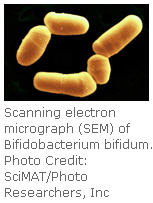|
Silver does NOT destroy Good bacteria
Two independent studies have been completed by two different major labs,
testing the effect of American Biotech Labs’ ASAP nano-silver on probiotic or
friendly and needed digestive bacteria. Both studies found that ASAP nano-silver
products would not even inhibit the growth of probiotic bacteria at all levels
at which it is being used.
ASAP solutions at both 10 & 22 ppm concentrations have not demonstrated anti-probiotic
activity. This makes ASAP the “ antibiotic of choice,” with no side effects and
not disturbing your body’s natural host defense mechanism. It complements
therapy by sparing essential host microflora as well as concomitant oral
lactobacilli therapy given as an adjunct.
Source: ABL,
“selective inaction of ASAP on probiotics,” March 2004. Silver
on probiotics Keith
Moeller, "Nano-Silver Proven Safe For Humans," American Biotech Labs Moeller
|
Probiotics are live microorganisms [ in most cases, bacteria ] that are
similar to beneficial microorganisms found in the human gut. They are also
called "friendly bacteria" or "good bacteria." Probiotics are available to
consumers mainly in the form of dietary supplements and foods.
Probiotics are not the same thing as prebiotics—nondigestible
food ingredients that selectively stimulate the growth and/or activity of
beneficial microorganisms already in people's colons. When probiotics and
prebiotics are mixed together, they form a synbiotic.
Probiotics are available in foods and dietary supplements (for example,
capsules, tablets, and powders) and in some other forms as well. Examples of
foods containing probiotics are yogurt, fermented and unfermented milk, miso,
tempeh, and some juices and soy beverages. In probiotic foods and supplements,
the bacteria may have been present originally or added during preparation.
 Most probiotics are bacteria similar to those naturally found in people's
guts, especially in those of breastfed infants (who have natural protection
against many diseases). Most often, the bacteria come from two groups,
Lactobacillus or Bifidobacterium.
Most probiotics are bacteria similar to those naturally found in people's
guts, especially in those of breastfed infants (who have natural protection
against many diseases). Most often, the bacteria come from two groups,
Lactobacillus or Bifidobacterium.
Friendly bacteria are vital to proper development of the immune system, to
protection against microorganisms that could cause disease, and to the digestion
and absorption of food and nutrients.
There are a few different terms that are used when discussing probiotics:
- Prebiotic - (greek - before life) a substance (usually an
oligosaccharide) that cannot be digested but does promote the growth of
beneficial bacteria or probiotics
- Probiotic - (for life) a substance that contains microorganisms
or bacteria that are beneficial to the host organism.
- Symbiotic - (plus life) a substance containing both a prebiotic
and probiotic.
The beneficial bacteria that make up our gut flora have many
functions in the body and are essential to our health. A search of medical
journals will find a huge number of experiments and articles of research on the
benefits of probiotics. Some these benefits include: enhancing bowel function,
prevention of colon cancer, cholestoral lowering, lowering of blood pressure,
improving immune function and reducing infections, reducing infammation,
improving mineal absorption, preventing growth of harmful bacteria, fighting off
diseases like candida and exzema, and many more
Probiotics are
dietary supplements of live
microorganisms thought to be healthy for the host organism. According to the
currently adopted definition by
FAO/WHO,
probiotics are: "Live microorganisms which when administered in adequate amounts
confer a health benefit on the host".[1]
Lactic acid bacteria (LAB) and
bifidobacteria are the most common types of
microbes used as probiotics; but also certain
yeasts and
bacilli are available. Etymologically, the term appears to be a composite of
the Latin preposition pro ("for") and the Greek adjective βιωτικός
(biotic), the latter deriving from the noun βίος (bios, "life").[2]
At the start of the 20th century, probiotics were thought to beneficially affect
the host by improving its intestinal microbial balance, thus inhibiting
pathogens and toxin producing bacteria
[3].
Today[when?]
specific health effects are being investigated and documented including
alleviation of chronic intestinal inflammatory diseases,[4]
prevention and treatment of pathogen-induced
diarrhea,[5]
urogenital infections,[6]
and atopic diseases.[7]
Research is emerging on the potential health benefits of multiple probiotic
strains as a health supplement as opposed to a single strain.[77][78]
The human gut is home to some 400-500 types of microbes. It is thought that this
diverse environment may benefit from multiple probiotic strains; different
strains populate different areas of the digestive tract, and studies are
beginning to link different probiotic strains to specific health benefits.
 Most probiotics are bacteria similar to those naturally found in people's
guts, especially in those of breastfed infants (who have natural protection
against many diseases). Most often, the bacteria come from two groups,
Lactobacillus or Bifidobacterium.
Most probiotics are bacteria similar to those naturally found in people's
guts, especially in those of breastfed infants (who have natural protection
against many diseases). Most often, the bacteria come from two groups,
Lactobacillus or Bifidobacterium.